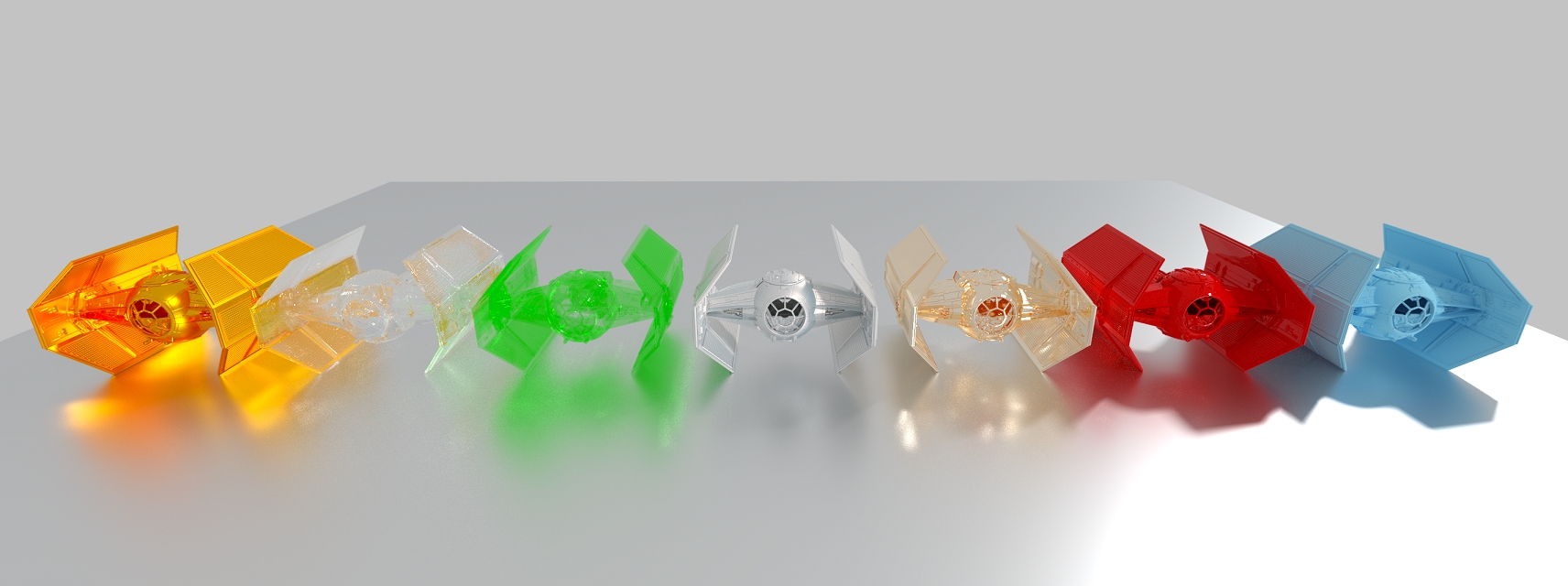VisRTX is a C++ rendering framework developed by the HPC Visualization Developer Technology team at NVIDIA.
- Progressive forward pathtracing with next-event estimation and multiple importance sampling
- Hardware acceleration through NVIDIA OptiX
- Full MDL material support for physically-based BSDFs
- AI denoiser
- Triangle/sphere/cylinder/disk geometries
- Directional/sphere/quad/spot/ambient/HDRI area lights
- Perspective/orthographic cameras
- Depth of field
- Picking
- Tone mapping
- OpenGL interop
- Dynamic loading of VisRTX library
- Simple C++ interface
Please note that this is a research project and work in progress.
VisRTX is supported on both Linux and Windows.
- CUDA 10 (Minimum: CUDA 8)
- OptiX 6 (Minimum: OptiX 5.1)
- MDL SDK 2019
- GLEW
VisRTX requires a C++ compiler and uses the standard CMake compilation and installation procedure.
mkdir build && cd build
cmake PATH_TO_VISRTX
make
make install| CMake Option | Description |
|---|---|
VISRTX_USAGE_REPORT_VERBOSITY |
Enables the usage report generated by OptiX. Possible values: 0/1/2/3. |
VISRTX_USE_DEBUG_EXCEPTIONS |
Compiles VisRTX and the underlying OptiX kernels with debug exception handling enabled. |
VISRTX_BUILD_SAMPLE |
Enables building of the sample applications. |
VISRTX_SAMPLE_USE_DYNAMIC_LOADING |
Use dynamic loading rather than dynamic linking in the samples to load VisRTX. |
On Windows, VisRTX can be compiled using Visual Studio's built-in CMake support.
Just place a CMakeSettings.json file with the following contents (adjust paths accordingly) next to VisRTX's CMakeLists.txt:
{
"configurations": [
{
"name": "x64-Release",
"generator": "Ninja",
"configurationType": "Release",
"inheritEnvironments": [
"msvc_x64_x64"
],
"buildRoot": "C:\\.build\\VisRTX\\${name}",
"installRoot": "C:\\.install\\VisRTX",
"cmakeCommandArgs": "",
"buildCommandArgs": "-v",
"ctestCommandArgs": "",
"variables": [
{ "name": "OptiX_INSTALL_DIR", "value": "C:\\PATH\\TO\\OptiX-SDK-6.0.0" },
{ "name": "MDL_INSTALL_DIR", "value": "C:\\PATH\\TO\\mdl-sdk-314800.830" },
{ "name": "GLEW_INCLUDE_DIR", "value": "C:\\PATH\\TO\\glew-2.1.0\\include" },
{ "name": "GLEW_LIBRARY_RELEASE", "value": "C:\\PATH\\TO\\glew-2.1.0\\lib\\Release\\x64\\glew32.lib" },
{ "name": "VISRTX_BUILD_SAMPLE", "value": "ON" },
{ "name": "VISRTX_SAMPLE_USE_DYNAMIC_LOADING", "value": "ON" },
{ "name": "VISRTX_USAGE_REPORT_VERBOSITY", "value": "0" },
{ "name": "VISRTX_USE_DEBUG_EXCEPTIONS", "value": "OFF" }
]
}
]
}
Several example applications are included showcasing and verifying the features of VisRTX.
The visRtxSampleBasic application combines most features of VisRTX in a single test bed using the general-purpose basic material.
The visRtxSampleMeshViewer can be used to load a set of arbitrary OBJ meshes and apply MDL materials to them.
visRtxSampleMDL loads a single mesh and renders multiple instances with various MDL materials.
The samples include a set of MDL material definitions based on the most common OSPRay materials with a similar parameter interface.
These include ::OBJMaterial, ::CarPaint, ::Principled, ::Metal, ::Alloy, ::Glass, ::ThinGlass, ::MetallicPaint, and can be found in sample/data/ospray.mdl.
Example command line: ./visRtxSampleMeshViewer ::OBJMaterial cow.obj ::CarPaint car.obj ::MetallicPaint --plane
The samples can be easily changed to load MDL files and resources from disk, or switch from instance to class compilation.
There is no official documentation yet, sorry!
The VisRTX.h header gives a concise overview of the API.
Most of the provided functionality is demonstrated in the included sample applications. See sample/Sample.h for basic framework setup.
Please note that this project is work in progress and the API as well as features can change.
Some performance-relevant properties of the renderer can be overridden using the following environment variables, so an existing application can be tuned without recompilation.
| Environment Variable | Values |
|---|---|
VISRTX_MIN_BOUNCES |
int > 0 |
VISRTX_MAX_BOUNCES |
int > 0 |
VISRTX_EPSILON |
float >= 0 |
VISRTX_CLAMP_DIRECT |
float >= 0 |
VISRTX_CLAMP_INDIRECT |
float >= 0 |
VISRTX_TONE_MAPPING |
0/1 |
VISRTX_DENOISER |
0/1 |
VISRTX_SAMPLE_ALL_LIGHTS |
0/1 |
For more advanced materials check out vMaterials, a curated collection of free-to-use MDL materials representing common real world materials used in Design and AEC workflows.
The MDL wrapper provided by VisRTX is self-contained and can be of interest to anyone who wants to access the MDL SDK from an OptiX-based application.
- Class and instance compilation
- Load MDL from memory and disk (including texture resources)
- Update parameters (and recompile if necessary)
- Arbitrary OptiX samplers as parameters
Feedback, issues and pull requests welcome!
We would love to hear more about your use cases of VisRTX!
If you have any questions, feature requests, issues, or ideas for improvement, please feel free to reach out at tbiedert@nvidia.com.
